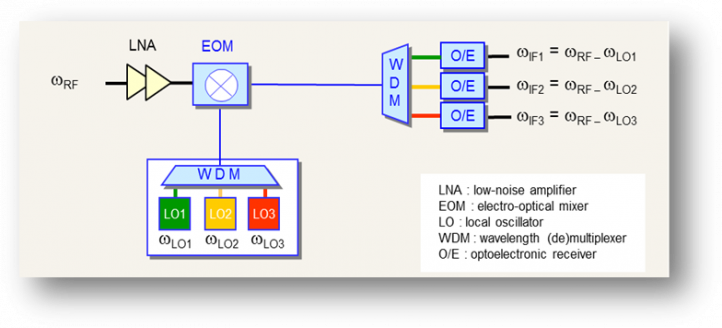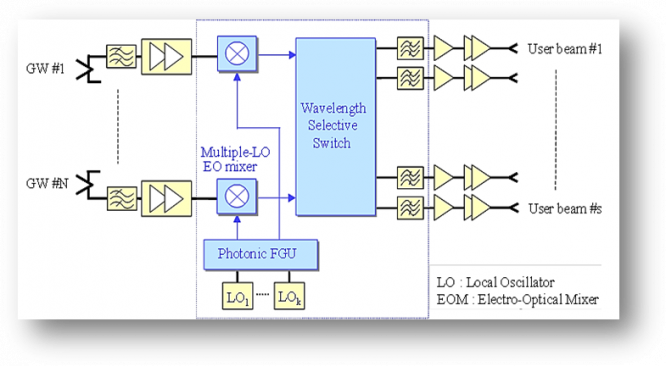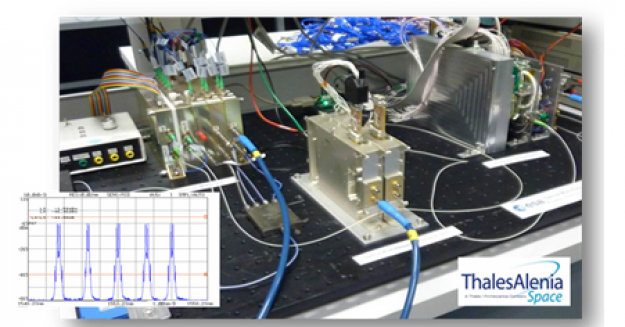
-
StatusCompleted
-
Status date2016-12-19
-
Activity Code5C.059
The project is concerned with the assessment of advanced optical reconfiguration concepts based on multiple-frequency conversion (OMC) for application in broadband transparent telecom repeaters. This is supported by the design and development of an engineering model of an Optical Multi-frequency Conversion Unit (OMCU) and its test in the environment of an Opto-Microwave Analogue Repeater (OMAR) breadboard.
The activity was split in two phases. The objective of Phase 1 is to identify applications and opto-microwave analogue repeater (OMAR) concepts making best use of the OMC concept, and to define a demonstrator representative of these applications.
Phase 2 is aiming at developing and testing this demonstrator.
The overall challenge is to demonstrate and assess the benefits of advanced optical reconfiguration concepts based on multiple-frequency conversion (OMC) in broadband transparent telecom repeaters applications.
 Principle of optical multi-frequency conversion (OMC)
Principle of optical multi-frequency conversion (OMC)
A first challenge is to identify telecom missions and payloads where microwave photonic system concepts can provide enhanced features and/or new capabilities. So-called OMAR (Opto-Microwave Analogue Repeater) are to be elaborated for enhancing the features and reconfiguration capabilities of future broadband telecom satellites.
Then, the challenge is to design and develop a representative model of such an Optical Multi-frequency Conversion Unit (OMCU) with RF performance equivalent to those of conventional transparent repeaters, and to test it in the system environment of an Opto-Microwave Analogue Repeater (OMAR) breadboard.
These results open the perspective of new payload solutions with in-orbit re-configurability, with in particular application to multi-beam broadband access mission in Ka-band and above.
In such a scenario, a small number of gateways can serve numerous user beams through forward and return payloads.

Reference frequency plan of the Forward and Return missions
The optical reconfiguration concept supports flexible gateway-to-user beam allocation and enables to change this allocation all along the mission, whereas today this interconnection remains fixed from the design phase. Whereas RF implementations would result in high complexity and large amount of hardware, photonic architectures and technologies make flexible payloads achievable with standard RF performance, and mass and power budgets compatible with existing platforms. This offers for instance the opportunities to deploy capacity stepwise, at lower risk and initial investments, or to implement more efficient management and redundancy strategies, which both can be turned into larger capacity and better exploitation of payload resource, at any time of the satellite life.
Lightweight, low power consumption, broad bandwidth, transparency to RF frequency bands are also essential features to meet the requirements of future broadband telecom satellites.
The photonic RF repeater concept and functionalities is successfully validated in Ka and Ku band, but they find applications in a broader range of payloads, with other architectural variants or larger scales. Also they can be easily extended to other frequency bands in particular Q/V, given the broadband nature of the technology and its transparency to the RF frequency.
A typical photonic payload architecture basically consists in conventional microwave low-noise receive front ends and high-power amplification chains in the transmit section, and features a photonic repeater, which acts as a space/frequency switch, and thus enables to route any RF sub-band from any input access port to any output access port and to shift its frequency position accordingly. More specifically, the photonic repeater core supports the following functions:
- optical distribution of centralized, high-frequency microwave Local Oscillator (LO) signals to numerous electro-optical mixers.
- photonic frequency-conversion of RF signals by means of electro-optical mixers.
- optical cross-connection of RF signals by means of micro-optical switches, with unique capabilities such as scalability to large port counts and RF frequency independence.
Electro-optical mixing offers attractive capabilities, out of which multiple frequency-conversion (OMC) performed by feeding the electro-optical mixer with several LO’s on separate optical carriers using wavelength-division-multiplexing (WDM).
Functional applications of the OMC technique were elaborated in more detail. OMC can be used for frequency routing, with frequency-band or frequency-slot interchange and enhance the reconfiguration flexibility of the photonic repeater architectures.
Such photonic architectures are found to exceed the capabilities of microwave/RF implementations, bringing drastic mass, power and volume savings, growing up to larger scales, and/or supporting in-orbit reconfiguration.
SYSTEM ARCHTIECTURE
OMAR implementations are designed for forward and return repeater respectively, based on similar architectures all making use of OMC concept, and on common optical building blocks. Figure below gives the general OMAR architecture considered for the forward repeater, similar architectures being proposed for the return repeater.
The Forward photonic payload consists in a photonic frequency-generation unit (FGU), a photonic frequency-down-converter assembly, and an optical reconfiguration section based on a wavelength-selective optical switching architecture. The Return payload iss based on the same principle, and on a similar implementation. All the LO’s are generated and transferred on optical carriers within the FGU and delivered to modulator-based electro-optical mixers. The Forward photonic FGU architecture is designed to provide 5 LO’s to all output ports. The Return FGU architecture is designed to provide 5 LO’s as well.

Photonic RF payload architecture for Forward repeater in multi-beam mission
RF signals received from up-link antenna accesses are transferred onto optical carriers at the electro-optical mixers. When the electro-optical mixer is fed by an optical LO, the input RF frequency is down-converted to an intermediate frequency (IF). Amplification, distribution and switching are performed in the optical domain by means of optical amplifiers and micro-optical switches in the wavelength-selective switching unit.
At the output of this latter stage, opto-microwave receivers convert the optical signals back into microwave ones at IF, and RF channel filtering is achieved by means of conventional RF filter technology. From estimations of complexity and budgets, it turns out that equivalent RF payload implementations would result in huge amount of hardware, and are thus considered today as almost unfeasible.
The activity is split in two phases.
The objective of Phase 1 is to identify applications and opto-microwave analogue repeater (OMAR) concepts making best use of the OMC concept, and to define a demonstrator representative of these applications.
Phase 2 is aiming at developing and testing this demonstrator. The OMAR demonstrator features a representative OMCU model, other units being developed at breadboard level.
The demonstrator is to be integrated and arranged in configurations representative of target applications. The overall functionality of the OMAR demonstrator is to be demonstrated and validated. The test campaign to be run at sub-system level includes all the conventional RF test items. The measured performance must be assessed versus the target performance and theoretical predictions.
The project has demonstrated innovative payload concepts making full use of RF photonics, wavelength-division multiplexing and optical switching technologies. This has been achieved through the development of a representative model of an Optical Multi-frequency Conversion Unit (OMCU) and its test in the system environment of an Opto-Microwave Analogue Repeater (OMAR) breadboard.

Integrated OMAR demo with the 5-LO optical spectrum
The demo has been arranged in configurations representative of multi-beam payload and flexible payload applications. The overall functionality is successfully validated in Ka-band and Ku-band but these concepts find applications in a broader range of payloads.
An extensive test campaign has been run at photonic repeater sub-system level which included all the conventional RF test items, namely RF gain, noise figure, linearity, gain flatness, gain stability, group delay variation, phase noise. The measured performance were found to be compliant with the target requirements, with only minor deviations with respect to theoretical predictions. Preliminary thermal tests have also been run.
Disruptive photonic payload concepts and technology have been developed and brought to higher maturity, with representative models of photonic payload equipment, including photonic FGU and frequency-converters and photonic routing solutions. The technology is ready for further development and shall be available for in-orbit demonstration (IOD) in the short term.




